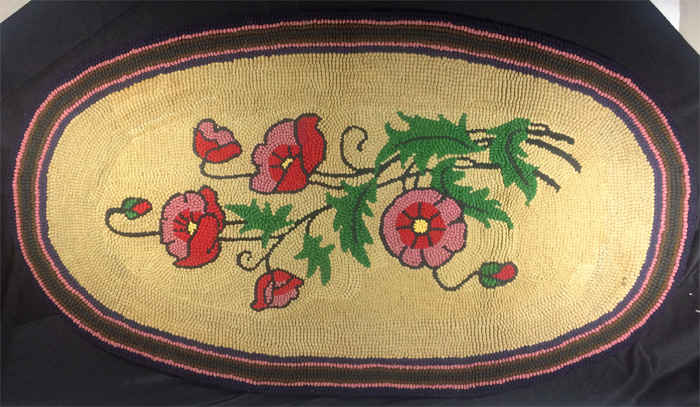Village News
MHV Receives Hooked Rug Donation

Most of the donors from whom Mennonite Heritage Village (MHV) receives artefacts have personal connections to the items they bring to us. They are often relics of family history, having been kept in a family for generations, and have become a way for their owners to connect to their past. Some artefacts hold these connections more deeply than others. We recently received a donation of a number of items that had once belonged to a woman whose short life ended in tragedy. Her wedding dress, a hooked rug, and a set of embroidered pillowcases are some of her daughter’s only connections to the mother she lost at an early age.
Anna (Penner) Friesen was married to Henry Friesen on July 21, 1918. They farmed and raised their children near Niverville, Manitoba. Around 1930, Anna developed tuberculosis and was placed in the St. Boniface Sanatorium (now known as the St. Amant Centre). She stayed there only until 1931, when she moved in with her parents, who cared for her until her death in December of the same year. She left a husband, three sons, and the youngest child, a four-year-old daughter, Anne.
Construction of the St. Boniface Sanatorium was an unemployment relief project during the Great Depression. Fully completed in 1931, the facility held 250 beds. According to Anna’s daughter, her mother was one of the first patients to stay at the sanatorium. Patients infected with tuberculosis, a contagious disease affecting the lungs, were isolated in such sanatoria, where they could rest and get fresh air and a good diet. Termed the “rest cure,” this was the common treatment for TB until the 1950s, when antibiotic treatment was developed. (Source: Canadian Public Health Association)
With all the “resting” that patients were to do, there was an excess of free time. Isolated without family in a sanatorium, Anna kept her hands and mind busy with needle and thread. The above-mentioned hooked rug and embroidered pillowcases were made by Anna during her time there.
Although not donated to our museum, the family also kept two braided plaits of Anna’s hair. According to Anne, her mother’s hair became very uncomfortable as she lay in bed for such long periods of time. At Anna’s request, her husband Henry cut off her long braids, which were then carefully stored for decades by Henry and later by his daughter. In 2017 these braids were donated to an organization that provides wigs to those who have experienced hair loss due to medical conditions.
These personal items show us how an object can act as a physical memory of something that has been lost. For Anna’s family, they have served as reminders of her since her death in 1931. They have been particularly treasured by her daughter, who never had the chance to really know her mother. Anne noted that her father rarely spoke of her mother over the years. However, it is clear through his preservation of her belongings that he wanted to keep a physical memory of Anna for himself and for his children.




